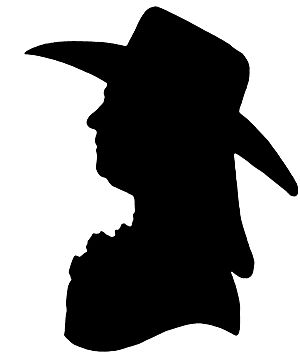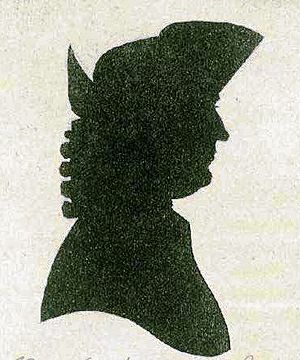White Watson facts for kids
Quick facts for kids
White Watson
|
|
|---|---|

self-silhouette
|
|
| Born | 10 April 1760 |
| Died | 8 August 1835 (aged 75) |
| Nationality | British |
| Parent(s) | Samuel and Martha White |
White Watson (born April 10, 1760 – died August 8, 1835) was an English geologist, sculptor, and artist. He was also a stonemason, marble worker, and mineral dealer. Like many smart people of his time, he was skilled in many areas. He worked as a writer, teacher, botanist, and gardener. He kept many diaries and sketchbooks about rocks, fossils, plants, and animals. He also published important books on geology. As an artist, he was famous for his silhouette art. These were made on paper and even carved into marble.
Contents
Early Life and Family History
White Watson was born near Sheffield on April 10, 1760. His father, Samuel Watson, made millstones. His mother was Martha White, which is where his first name, White, came from. White Watson's great-grandfather and grandfather were also named Samuel Watson. They were sculptors and stonemasons. They helped rebuild Chatsworth House between 1687 and 1706. White Watson later continued this family tradition. He also worked for the Chatsworth Estate.
Learning About Rocks and Minerals
As a child, Watson became very interested in minerals and fossils. He started his own collection. He also sold specimens in his uncle's shop. His uncle, Henry Watson, was a marble sculptor. He worked in Bakewell and Ashford-in-the-Water since the 1750s. Henry Watson built a marble mill in Ashford-in-the-Water. He helped start the trade in local Blue John fluorite and Ashford Black Marble. He also made the amazing black and white marble floor for the Great Hall at Chatsworth House in 1779.
When White Watson was 14, he left Sheffield School. He went to live with his uncle and became his apprentice in 1774. He formally began collecting fossils and marbles that same year. By 1782, he was advertising his skills as a sculptor and engraver. He also helped his uncle run the business.
Creating Geological Tablets

In 1785, Watson made a special "Tablet" for geologist John Whitehurst. It was called 'A Section of a Mountain in Derbyshire'. This tablet was made from actual rock samples. It showed a diagram of how rocks are layered. This was a new way to display geological ideas. It also showed an early understanding of how rock layers (strata) are formed. This was the first time someone tried to map the rock layers of all of Derbyshire.
Over his life, Watson made about 100 such tablets. Each came with a leaflet to explain it. Sadly, most of these tablets are now lost. Only about fifteen are known to still exist.
Starting His Own Business
Henry Watson died in 1786. The Ashford-in-the-Water business was then sold. After this, White Watson became a marble finisher. For many years, he made gravestones and church marbles. He also became a fossil and mineral dealer. He had his own shop and museum in Bakewell. He kept it until he died. White Watson was key in making Ashford Black Marble popular. This is a type of limestone that is very black and smooth.
Working with William Martin
In the early 1790s, Watson worked with William Martin. They planned to create a book about Derbyshire's Carboniferous Limestone fossils. Watson had tried to get money for this book since 1790. He even made a one-page plan for it. However, after they started working together, Martin began publishing parts of the book on his own. He used Watson's text and pictures but gave him almost no credit. Because of this, they had a falling out. Martin later republished the series under his own name in 1809. He did not give any credit to Watson at all.
Joining Important Societies
Watson was chosen as a member of the Linnean Society in 1795. He stayed a member until he died. He also joined the Derby Philosophical Society in 1800. He was suggested by Georgiana, the Duchess of Devonshire. He was also a member of the British Mineralogical Society.
In 1798, he redesigned a grotto at Chatsworth House. He made it into a crystal cave filled with fossils. This cost him a lot of money. The grotto there today is a newer one from the 1830s. Watson continued to work for the Chatsworth Estate. He was hired in 1799 to organize the important mineral collection. This collection was started by Georgiana, Duchess of Devonshire. He also organized the mineral collection of Lady Henrietta of Bessborough, Georgiana's sister.
Later Life and Geological Discoveries
In 1804, Watson was asked to work on the rest of Georgiana's collection. This was the Chatsworth Mineral Collection. He added many new items to it. This helped him understand rocks and minerals even better. By this time, Watson was well-known in natural history. Many people visited his collection at The Bath House in Bakewell. He lived there and managed the Baths. One visitor wrote that Watson was "rather below the middle stature with a pug face, is a bachelor and takes his glass of spirits and water at the Inn in Bakewell every evening." Other famous visitors included Sir Joseph Banks and Erasmus Darwin.
In 1808, Watson married Ann Thorpe, who was 29. She was a relative of Sir Isaac Newton. That same year, he made a detailed cross-section of Derbyshire's rock layers. He gave it to the Duke of Devonshire.
The Delineation of the Strata of Derbyshire
From 1810, Watson made many tablets of this section. Based on these, he published an important book in 1811. It was called The Delineation of the Strata of Derbyshire. This book was made when geology was still a new science. But his sections were very accurate. They described 36 rock layers in Derbyshire. The book included a long fold-out map of almost the entire width of Derbyshire. Watson's notes show he agreed with Abraham Werner's ideas about geology. The Delineation also discussed Werner's theories.
Watson published other sections of Derbyshire between 1813 and 1831. He also made many local geological sections of peaks and cliffs, like Mam Tor. In 1813, he wrote a pamphlet that disagreed with John Farey. Farey was another geologist who had made a geological map of Derbyshire. Watson and Farey disagreed about the details of Derbyshire's geology. Watson correctly believed that the Derbyshire mountains were formed by underground volcanic action. Farey thought they were formed by "satellite attraction from above." Despite their disagreements, they met several times to discuss their findings.
Later Years and Legacy
In 1825, the year Ann died, Watson's business card said he "executes monuments, tombs etc., gives lessons in geology and mineralogy and furnishes collections, affords information to antiquaries and amusement to Botanists." Around the same time, Watson made a unique circular diagram of rock layers. It showed the ten deepest layers found in Derbyshire. The layers were arranged in circles, from oldest rocks in the center to youngest rocks at the edges.
Later in his life, Watson designed improvements for Bakewell Baths. He lived there, and the Duke of Rutland wanted to make Bakewell a popular spa town. This project did not fully succeed. However, Watson was responsible for the Bath Gardens laid out in the town. These gardens still exist today.
Despite all his hard work, Watson was always in debt. He died still trying to pay his bills by selling much of his fossil collection. His cash records show he was often close to going bankrupt.
White Watson died in Bakewell on August 8, 1835. He is buried in Bakewell churchyard. He did not have any children.
Surviving Works
After his death, his collections were split up and sold. However, examples of his marble and limestone work still exist. These include the tomb of the Foljambe family at Bakewell Church. There is also a plaque at St George's Chapel, Windsor, for George III from 1789. Many of his geological tablets also survive. His tablets 'A Section of a Mountain in Derbyshire' and 'A Section of the curious curvilinear Strata at Ecton Hill' are now at Derby Museum and Art Gallery.
Other surviving tablets are in the British Museum (Natural History), London, Oxford University Museum, Bakewell Old House Museum, Chatsworth House, Manchester Museum, and Leicester Museum. Watson's handwritten list of the Chatsworth Mineral Collection is still kept at Chatsworth House. Many of the specimens he provided are also there. The collection, including many of Watson's own specimens, has been largely restored at Chatsworth House. A catalogue he wrote in 1798 was found during this restoration. His diaries from 1780–1831 are in the Bagshawe Collection in Sheffield City Library. His fossil catalogues are also there. Other private papers, notes, and sketches are held in Sheffield Library and Derby Library. An album of his silhouettes from 1806 is also in Derby Library.



